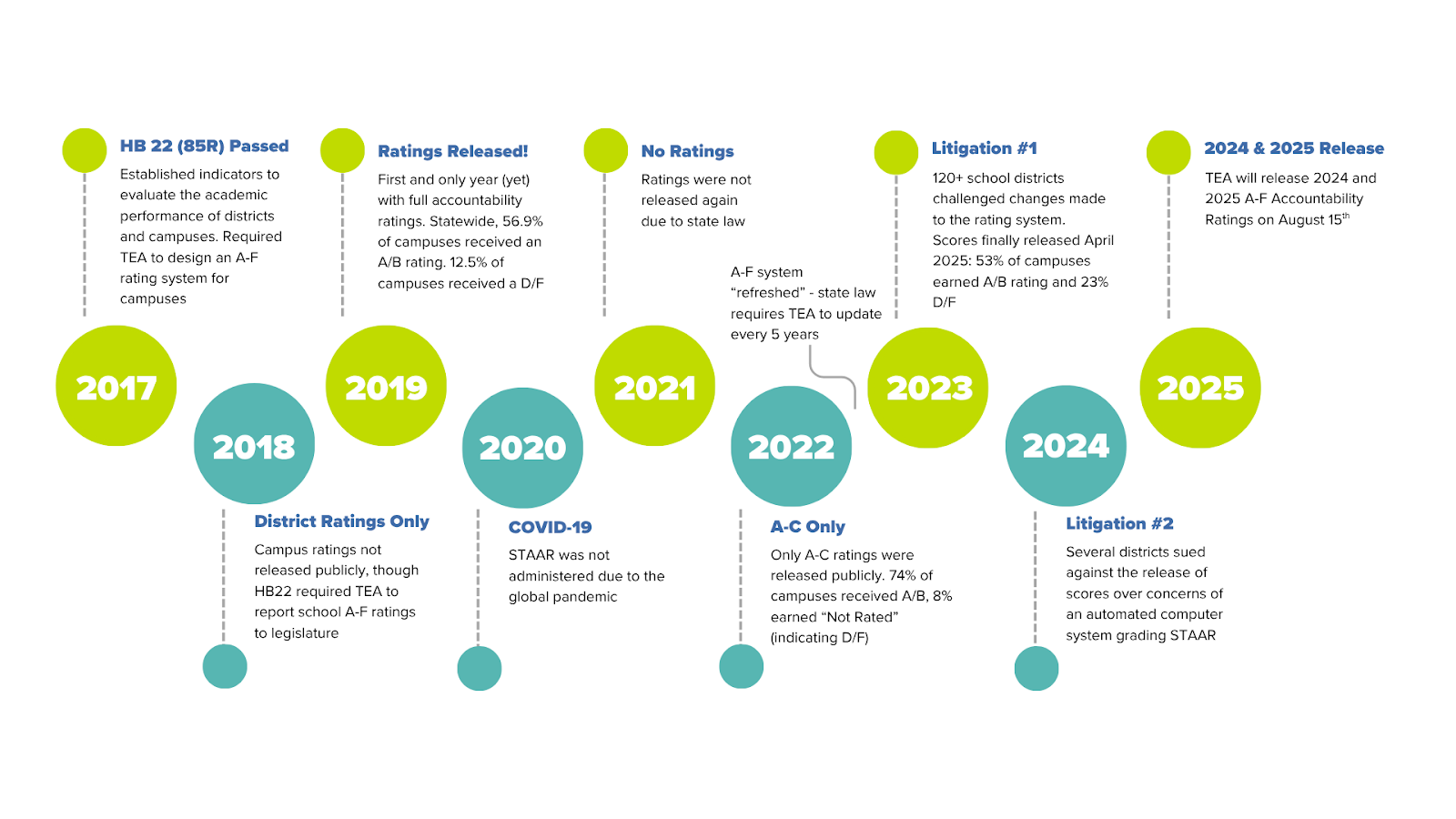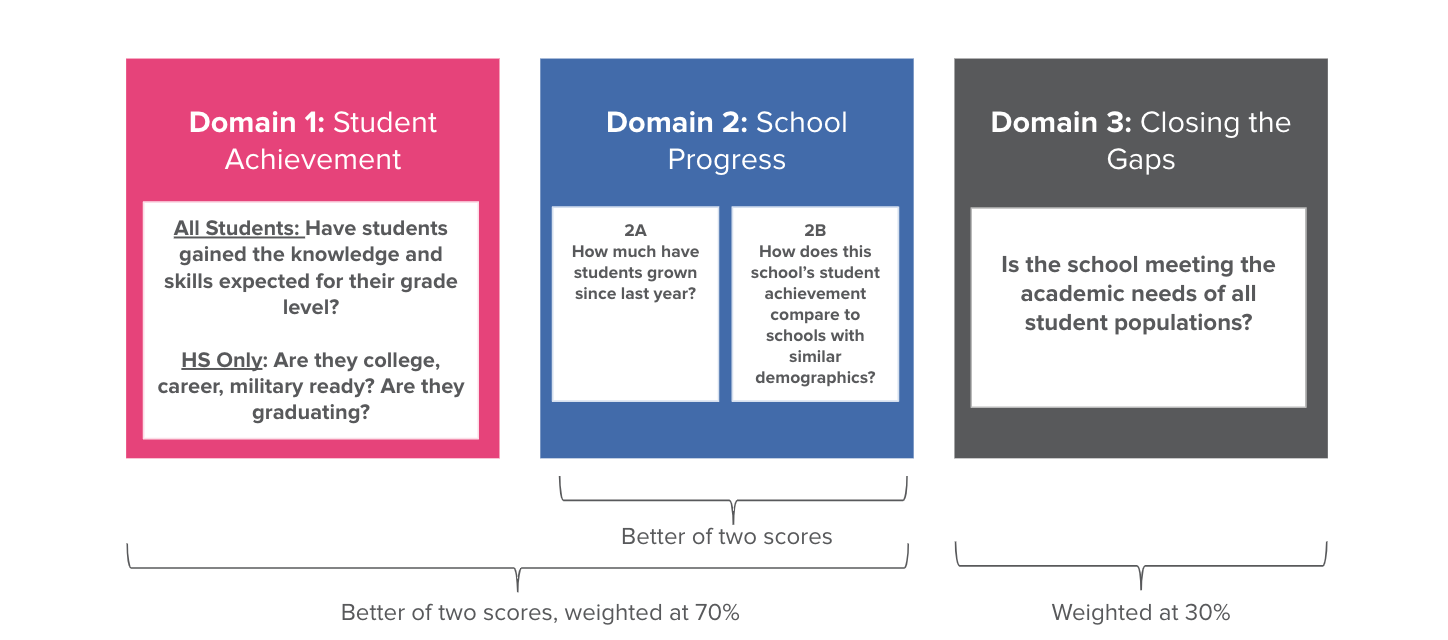This week, the Texas Education Agency (TEA) will release A-F Accountability Ratings for Texas public schools and districts for both the 2023-24 and 2024-25 school years. For Houston families, these ratings provide crucial insight into how well local schools are preparing students for success beyond graduation—and ultimately, for earning a living wage in our community.
This marks the state’s first on-time ratings release since the 2021-22 school year. Legal challenges related to a comprehensive refresh of the A-F accountability framework delayed the release of ratings in 2023 and 2024. Now, with three years of data under the updated system, families and educators have a clearer picture of performance and progress.
How A-F Ratings Came to Be in Texas
First implemented for the 2018-19 school year, the A-F Accountability System provides families, communities, and other stakeholders a measure of how well schools are helping students meet state academic standards. The COVID-19 pandemic brought significant disruptions to learning and teaching, and eventually resulted in the TEA pausing A-F ratings for two years to allow districts to focus on recovery and adaptation.
For the 2022-23 school year, the TEA refreshed the A-F grading system as required by House Bill 22. Lawsuits brought by school districts delayed the release of these updated ratings for 2022-23 and 2023-24. Courts have since cleared the way for the release of data from both years. The 2022-23 ratings were released this past April, while the 2023-24 ratings will come out alongside the 2024-25 ratings on August 15th, providing us with three years of information on school progress under the refreshed rating system.
The 2023 refresh of the rating system raised expectations for schools across the board, signaling Texas’ intent to push for higher, more equitable standards. These changes included:
- Increased rigor for College, Career, and Military Readiness (CCMR) standards
- Awarding additional credit for incremental student growth
- Adjustments to tracking of progress across various student groups

TEA calculates accountability ratings by examining performance across three domains:
- Domain 1: Student Achievement – Measures absolute performance across State of Texas Assessments of Academic Readiness (STAAR) tests, CCMR indicators, and high school graduation rates.
- Domain 2: School Progress – Assesses academic growth on STAAR tests (Part A), or compares campus performance to peer campuses with similar student demographics (Part B). The higher score between Part A and B is used.
- Domain 3: Closing the Gaps – Compares achievement of specific student groups to determine if learning gaps exist between groups and whether progress is being made to close those gaps.

Campuses and districts receive a score (0-100) for each domain, which is then converted into a letter grade. The higher score from Domain 1 (Student Achievement) or Domain 2 (School Progress, higher of Part A or B), determines 70% of the overall rating, while the Closing the Gap domain accounts for 30%.
Per state law, the TEA commissioner is required to intervene in districts with campuses receiving D or F overall ratings in five consecutive school years.
Keeping it 100 (Literally): Why A-F Ratings Matter for Student Success
Accountability ratings are a critical, data-driven tool for transparency and continuous improvement to ensure students are meeting expectations in core academic areas like reading and math. Ratings provide families and communities clear information about school performance and are used by districts to allocate resources and implement additional resources or supports as needed. These supports may include strategic staffing decisions, professional learning and coaching, and instructional interventions.
Though the A-F system is critical to ensuring our education system is adequately serving all students, factors outside the accountability framework are also crucial to student success. Research shows that participation in advanced coursework, social-emotional learning, extracurricular engagement, and school culture all contribute to a student’s overall development and long-term outcomes, promoting essential skills like critical thinking, resilience, and collaboration.
What This Means for Houston
For Houston-area families, these ratings represent more than letter grades– they’re indicators of whether students are on track for the opportunities they deserve. Strong school performance connects directly to economic mobility, helping ensure every child in every neighborhood has access to a high-quality education that opens doors to career success.
While no single system can capture every dimension of student success, the A-F accountability system provides an objective and transparent measure of whether schools are meeting the academic standards students deserve. The return of comprehensive A-F ratings helps ensure accountability and progress toward our shared goal of educational excellence..
Curious how your school performed? Check out Good Reason Houston’s upcoming analysis and insights in the coming weeks to find out how schools across the region stack up. We’ll break down what these ratings mean for students, families and our city’s future.
TL;DR (Too Long Didn’t Read):
https://player.vimeo.com/video/799143280?h=cd5318e06a
Good Reason Houston is committed to making Houston the leading education city in the nation. We are working to double the rate of public school graduates earning a living wage by 2040.





